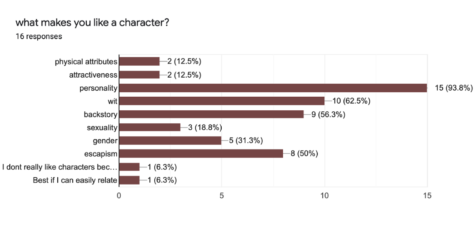Comfort Characters: An Exploration of Fandoms and Fiction
What drives people to confide in fictional characters?
When dealing with comfort characters, the line between reality and make-believe is often uncertain. Reading has been studied to bring down levels of stress by up to sixty eight percent and its narratives bring in greater empathy and understanding. However, there is a large difference between using these stories for greater emotional connection and dissociation from reality.
My local librarian used to smile as I checked out ten, sometimes fifteen, books in a day. I tried with all my might not to drop the stack as I raced home, filled with anticipation for the worlds I would discover in the coming pages.
Motivated by the overwhelming sense of loneliness that the Coronavirus pandemic inspired, I returned to some of my old favorite books and have since reread those series several times over. Although they are no longer challenging reads, these books envelop me in feelings of nostalgia and calm. And despite much of the time that I used to dedicate to pouring over fantastical books being reallocated to obsessing with new Netflix releases, the same devoted behavior carries over into online mediums, infusing my day with new comfort.
We spend roughly a quarter of our lives watching media on electronics. The average American adult watches almost six hours of television and video each day. And, even though there are plenty of serious downsides to technology, such as addiction, television has been proven to make us feel happier, at least temporarily.
The connection between television and emotional comfort is supported by research conducted by researchers Patrick Barwise, Steven Bellman, and Virginia Beal. They found that TV actually fulfills our psychological tendencies toward escapism and relaxation while remaining a cheap, easily available option. This study used electroencephalography – the process of tracking and understanding the brain’s electrical activity – and reaction-time measures to find that watching TV and video actually “generated brainwaves associated with pleasant, wakeful relaxation and absorbed cognitive capacity, taking viewers’ minds off other things.” It is no surprise, then, that many seek relief in these distractions and in the characters involved.
Within the larger context of fictional media, this is represented by the emerging phenomenon of building affinity for specific figures known as “comfort characters.” The term “comfort character” originated, in fact, on Tumblr and has grown onto more mainstream platforms, such as TikTok and Instagram. There are countless Buzzfeed quizzes, ‘Twitter imagines,’ Spotify playlists, and Instagram fanposts dedicated to the subject.

Comfort characters can be defined by factors such as relatability, personality, sense of humor, or opportunity for escapism. They may take on any role in the story arc, but they are usually considered to be resilient in the face of struggles, deeply loyal to their community, and/or ambitious about their future.
Yyra Takat ’25 defined a comfort character as “a character from any piece of art or literature that has attributes such that if they were to be in your life/you in theirs, [it would allow for] a great deal of mutual trust and feelings of safety, [such as] Cinderella, recently Spider-Man (Miles Morales and/or Peter Parker).” Wagiha Mariam ’22’s definition of a comfort character is “someone who I can watch without a lot of mental energy, inspires me, and is heavily relatable.”
Comfort characters provide us with the opportunity to invest in someone else’s life from a safe distance. As Karen Lu wrote in her Emotionally Bonding With A Fictional Character? There’s A Term For That: ‘Comfort Characters’ article, “Whether [comfort characters are] conquering a villain, avenging a fallen friend, or simply being happy, people find warmth in following along in their journey or seeing them smile in the face of their own tragedy.”
Through these different ways of connection, comfort characters become mediums with which people can identify or find solace. One of Mack Adolf ’24’s comfort characters is Darryl, from the TV comedy-drama show Crazy Ex-Girlfriend. Adolf shared that Darryl was a favorite “because he reminds me of all the reasons people cite when they say they like me. It feels like I’m watching a better version of me living his life, and maybe I can finally believe those reasons, if just for a moment.”
Comfort characters can serve as role models, guiding figures, or even friends, dealing with similar struggles as that of the person and often equipped with the same characteristics that person wants to emulate.
Takat expresses this point. “Since I often relate to and/or admire [these characters], if they have certain traits, I may try to mirror them/embrace those characteristics so that I may be more similar to them, for example, in the Marvel Cinematic Universe, Peggy Carter’s confidence and Kamala Khan’s cultural resonance, as well as many characters who are misunderstood instead of villains.”
Watching the static behavior of comfort characters offers respite when life is unpredictable, an escape from reality, and a way to cope with struggles by living vicariously through them. People also often turn to these “safe” characters so they feel less alone. Lydia Du ’24 notes that “It’s nice to ‘connect’ to someone you relate to, even if they’re fictional.”
Those who struggle with anxiety report that channeling their comfort characters can lessen the intensity of such emotions. For some, the process of rereading fanfictions of their comfort characters, rewatching scenes of them, or some other form of engagement can possibly prevent anxiety attacks and even provide relief in panic episodes. So, it is quite a good thing that media is so widely accessible these days; if one requires a distraction they can reach their comfort characters with ease.
In fact, having a comfort character can be a sign of strong empathy, as Dr. Karen Dill-Shackleford explained, in a Refinery29 article, “You have to engage in a real human way in order to feel that connection. That’s probably a sign that you are capable of certain social things that you are willing to let yourself go and really feel something in the story.”

Comfort characters often grow beyond the personal level and develop into “fandoms,” which are communities formed around a piece of media. Online fandoms dominate social media platforms with fan accounts dedicated to favorite characters, artwork, and even their own fanfiction, whereupon they write their favorite characters into alternate realities.
This medium is a crucial part of fandom culture. Du stated, “Fanfiction makes up a majority of my reading material nowadays. I see fandom as a (mostly) positive way to connect to others that also deeply enjoy a piece of media, which makes it easier when I latch onto a comfort character or two from a particular series or movie and crave more content featuring them.”
Researcher, professor, and fandom expert Dr. Jessica Hautsch said to me in a recent interview for The Science Survey, “We can’t separate emotions, body and thinking. That is all part of the same cognitive system. So when thinking about fanfic, it’s both ends. It’s this comforting emotional experience, but it’s also artistic and analytical… When we talk about a character, we’re talking about words on a page or images on a screen that we then construct into an understanding of the character. And that’s why different segments of fandoms can have such different interpretations of the same character. It’s because we’re picking and choosing what gets incorporated into our understanding of who the character is. That ties in, interestingly, with your idea of comfort characters. It’s something that we are constructing and focusing on.”
She continued: “Fanfiction is repetitive in nature. But that’s part of the appeal of it. I want to read ten of them [fanfiction stories] in a row. Because there’s something really pleasurable about that experience, the emotional experience of engaging with those stories and with fanfiction.”
There are thousands of fanfictions on various platforms devoted to different characters or “ships” – characters that the reader/viewer wants to join together in a romantic relationship. By finding this constant comfort in similar formats or regarding similar people, the reader can escape to their fictional world for a longer amount of time than otherwise; once a series is completed, there is no more canonized content, but fanfiction may be written about any character at any time and constantly updated.
Dr. Hautsch added: “There’s something really pleasurable in engaging with it on a meta emotional level, meaning it’s not necessarily the emotion that you’re having. So we talk about it in terms of what’s called meta emotion. Meta emotion is the emotion that you have about emotion. Part of what fandom does is allow us to rehearse these emotions [crying, laughing, angst]. And to get to re-experience these emotions and particularly with these characters that we have parasocial emotions or relationships with.”
Parasocial relationships are one-sided relationships between media consumers and some aspect of the media, whether it is a celebrity or even a character, where the latter does not ever interact with the former (or may not even really exist), but the consumer continues to rely on connection for stability. When real life is insufficient, these affinities may be used to replace in-person bonds.
As Dr. Sudeepta Varma shared in an article with the Vulture, “We all have a need to be a part of something bigger than ourselves,” she said. “There is a degree of escapism and avoidance, but there’s hope and optimism. There is camaraderie. A common shared interest brings people together.”
Fandoms can also provide insight into mental health. Not only do these groups allow participants to communicate and feel a part of a community larger than themselves, but such strong social connections can actually ward against many health conditions, including heart disease.
However, obsession with any piece of media can be dangerous in the extreme, and comfort characters are no different. Overreliance on a fictional character can leave one vulnerable to harm, such as if the character dies or acts in an uncomfortable way or if its author or actor is found to be problematic (i.e., J.K. Rowling), which can rob the stories of their meaning and jeopardize the emotional connection one has grown to rely on.
That does not mean having comfort characters is problematic. On the contrary, it can bring considerable stability, but one should be careful about relying on any singular figure for fulfillment. Comfort characters are not therapy. They may be a source of help, but they cannot replace professional help if needed.
That said, if kept in moderation, there is nothing wrong with enveloping oneself in the comfort of a familiar, deeply loved story and its characters.
Watching the static behavior of comfort characters offers respite when life is unpredictable, an escape from their reality, and a way to cope with struggles by living vicariously through them. People also often turn to these “safe” characters so they feel less alone. Lydia Du ’24 notes that “It’s nice to ‘connect’ to someone you relate to, even if they’re fictional.”
Hallel Abrams Gerber is an Editor-in-Chief for ‘The Science Survey,’ using her writing to represent a myriad of social issues and innovations, bolster...

